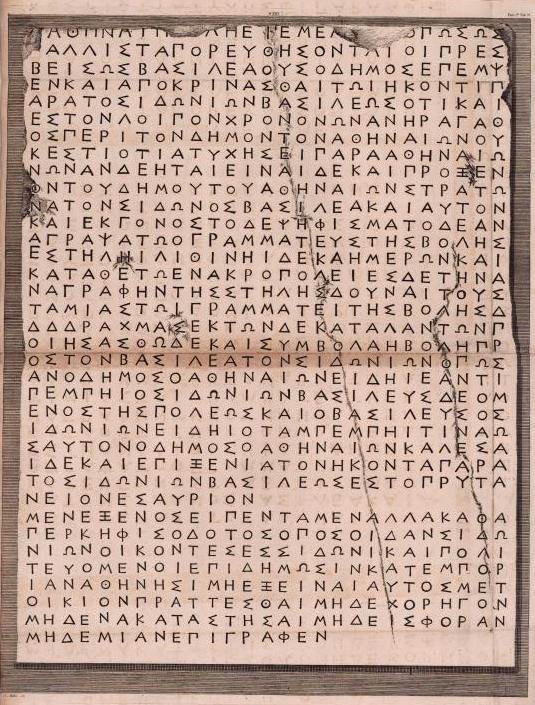CIG I = Boeckh, A. (ed.) (1828). Corpus Inscriptionum Graecarum I. Berlin (nrr. 1-1792).
CIG I = Boeckh, A. (ed.) (1828). Corpus Inscriptionum Graecarum I. Berlin (nrr. 1-1792).
HGIÜ II = Brodersen, K.; Günther, W.; Schmitt, H.H. (a cura di) (1996). Historische Griechische Inschriften in Übersetzung, vol. II: Spätklassik und früher Hellenismus (400-250 v. Chr.). Darmstadt.
HGIÜ II = Brodersen, K.; Günther, W.; Schmitt, H.H. (a cura di) (1996). Historische Griechische Inschriften in Übersetzung, vol. II: Spätklassik und früher Hellenismus (400-250 v. Chr.). Darmstadt.
I.Délos I = Durrbach, F. (ed.) (1926). Inscriptions de Délos I. Paris.
I.Délos I = Durrbach, F. (ed.) (1926). Inscriptions de Délos I. Paris.
IG II.1 = Koehler, U.; Kirchhoff, A. (edd.) (1877). Inscriptiones Graecae. Inscriptiones Atticae aetatis quae est inter Euclidis annum et Augusti tempora Part I. Berlin (nos. 1-641).
IG II.1 = Koehler, U.; Kirchhoff, A. (edd.) (1877). Inscriptiones Graecae. Inscriptiones Atticae aetatis quae est inter Euclidis annum et Augusti tempora Part I. Berlin (nos. 1-641).
IG II[2].1.1 = Kirchner, J. (ed.) (1913). Inscriptiones Graecae. Voll. II et III, Inscriptiones Atticae Euclidis anno posteriores. Part 1, Decrees and Sacred Laws. Fasc. 1. Ed altera. Berlin (nos. 1-1369 in fasc. 1 e 2).
IG II[2].1.1 = Kirchner, J. (ed.) (1913). Inscriptiones Graecae. Voll. II et III, Inscriptiones Atticae Euclidis anno posteriores. Part 1, Decrees and Sacred Laws. Fasc. 1. Ed altera. Berlin (nos. 1-1369 in fasc. 1 e 2).
Kirchner, PA = Kirchner, J. (ed.) (1901). Prosopographia Attica. Berlin.
Kirchner, PA = Kirchner, J. (ed.) (1901). Prosopographia Attica. Berlin.
MGHI = Hicks, E.L. (ed.) (1882). A Manual of Greek Historical Inscriptions. Oxford.
MGHI = Hicks, E.L. (ed.) (1882). A Manual of Greek Historical Inscriptions. Oxford.
MGHI² = Hicks, E.L.; Hill, G.F. (eds.) (1901). A Manual of Greek Historical Inscriptions. Oxford (II edizione).
MGHI² = Hicks, E.L.; Hill, G.F. (eds.) (1901). A Manual of Greek Historical Inscriptions. Oxford (II edizione).
Michel, Recueil = Michel, C. (éd.) (1897-1900). Recueil d'inscriptions grecques. Brussels (https://archive.org/search.php?query=michel%20recueil%20d%27inscriptions%20grecques).
Michel, Recueil = Michel, C. (éd.) (1897-1900). Recueil d'inscriptions grecques. Brussels (https://archive.org/search.php?query=michel%20recueil%20d%27inscriptions%20grecques).
Rhodes - Osborne, GHI = Rhodes, P.J.; Osborne, R (eds.) (2003). Greek Historical Inscriptions, 404-323 B.C. Oxford.
Rhodes - Osborne, GHI = Rhodes, P.J.; Osborne, R (eds.) (2003). Greek Historical Inscriptions, 404-323 B.C. Oxford.
Rhodes, Boule = Rhodes, P.J. (ed.) (1972). The Athenian Boule. Oxford.
Rhodes, Boule = Rhodes, P.J. (ed.) (1972). The Athenian Boule. Oxford.
Syll. I = Dittenberger, W. (a cura di) (1883). Sylloge Inscriptionum Graecarum, 1st ed. Vol. I. Ausg. Leipzig.
Syll. I = Dittenberger, W. (a cura di) (1883). Sylloge Inscriptionum Graecarum, 1st ed. Vol. I. Ausg. Leipzig.
Syll.² I = Dittenberger, W. (ed.) (1898-1901). Sylloge Inscriptionum Graecarum, Bd. I, 2. Ausg. Leipzig.
Syll.² I = Dittenberger, W. (ed.) (1898-1901). Sylloge Inscriptionum Graecarum, Bd. I, 2. Ausg. Leipzig.
Syll.³ I = Dittenberger, W. (ed.) (1915-1924). Sylloge Inscriptionum Graecarum, Bd. I, 3. Ausg. Leipzig.
Syll.³ I = Dittenberger, W. (ed.) (1915-1924). Sylloge Inscriptionum Graecarum, Bd. I, 3. Ausg. Leipzig.
Tod, GHI II = Tod, M.N. (a cura di) (1948). A Selection of Greek Historical Inscriptions II. From 403 to 323 B.C. Oxford.
Tod, GHI II = Tod, M.N. (a cura di) (1948). A Selection of Greek Historical Inscriptions II. From 403 to 323 B.C. Oxford.
Veligianni, Wertbegriffe = Veligianni-Terzi, Ch. (1997). Wertbegriffe in den attischen Ehrendekreten der klassischen Zeit. Stuttgart.
Veligianni, Wertbegriffe = Veligianni-Terzi, Ch. (1997). Wertbegriffe in den attischen Ehrendekreten der klassischen Zeit. Stuttgart.
Ameling, W. (1990). «Κοινὸν τῶν Σιδωνίων». ZPE, 81, 189-199.
Ameling, W. (1990). «Κοινὸν τῶν Σιδωνίων». ZPE, 81, 189-199.
Austin, R.P. (a cura di) (1938). The Stoichedon Style in Greek Inscriptions. Oxford.
Austin, R.P. (a cura di) (1938). The Stoichedon Style in Greek Inscriptions. Oxford.
Austin, R.P. (1944). «Athens and the Satraps’ Revolt». JHS, 64, 98-100.
Austin, R.P. (1944). «Athens and the Satraps’ Revolt». JHS, 64, 98-100.
Aymard, A. (1948). «Le protocole royal grec et son evolution». REA, 50, 232-263.
Aymard, A. (1948). «Le protocole royal grec et son evolution». REA, 50, 232-263.
Babelon, E. (a cura di) (1893). Catalogue des monnaies grecques de la Bibliothèque Nationale. Les Perses Achéménides, les satrapes et les dynastes tributaires de leur empire. Cypre & Phenicie, 2 voll. Paris.
Babelon, E. (a cura di) (1893). Catalogue des monnaies grecques de la Bibliothèque Nationale. Les Perses Achéménides, les satrapes et les dynastes tributaires de leur empire. Cypre & Phenicie, 2 voll. Paris.
Bleckmann, F. (a cura di) (1913). Griechische Inschriften zur griechischen Staatenkunde. Bonn (https://archive.org/details/griechischeinsch00blec).
Bleckmann, F. (a cura di) (1913). Griechische Inschriften zur griechischen Staatenkunde. Bonn (https://archive.org/details/griechischeinsch00blec).
Chandler, R. (a cura di) (1763). Marmora Oxoniensia. Oxford.
Chandler, R. (a cura di) (1763). Marmora Oxoniensia. Oxford.
Culasso Gastaldi, E. (a cura di) (2004). Le prossenie ateniesi del IV secolo a.C. Gli onorati asiatici. Alessandria.
Culasso Gastaldi, E. (a cura di) (2004). Le prossenie ateniesi del IV secolo a.C. Gli onorati asiatici. Alessandria.
Dinsmoor, W.B. (1932). «The Burning of the Opisthodomos at Athens». AJA, 36, 143-172, 307-326.
Dinsmoor, W.B. (1932). «The Burning of the Opisthodomos at Athens». AJA, 36, 143-172, 307-326.
Eiselen, F.C. (a cura di) (1907). Sidon: a Study in Oriental History. New York.
Eiselen, F.C. (a cura di) (1907). Sidon: a Study in Oriental History. New York.
Elayi, J. (a cura di) (1988). Pénétration grecque en Phénicie sous l'empire perse. Nancy.
Elayi, J. (a cura di) (1988). Pénétration grecque en Phénicie sous l'empire perse. Nancy.
Elayi, J. (a cura di) (1990). Sidon, cité autonome de l'Empire perse. Paris Seconda edizione.
Elayi, J. (a cura di) (1990). Sidon, cité autonome de l'Empire perse. Paris Seconda edizione.
Elayi, J. (a cura di) (2005). 'Abd'Aštart Ier, Straton de Sidon: un roi phénicien entre Orient et Occident. Paris.
Elayi, J. (a cura di) (2005). 'Abd'Aštart Ier, Straton de Sidon: un roi phénicien entre Orient et Occident. Paris.
Gauthier, P. (a cura di) (1972). Symbola: les étrangers et la justice dans les cités grecques. Nancy.
Gauthier, P. (a cura di) (1972). Symbola: les étrangers et la justice dans les cités grecques. Nancy.
Harding, P. (ed.) (1985). Translated Documents of Greece and Rome, vol. II: From the End of the Peloponnesian War to the Battle of Ipsus. Cambridge.
Harding, P. (ed.) (1985). Translated Documents of Greece and Rome, vol. II: From the End of the Peloponnesian War to the Battle of Ipsus. Cambridge.
Heilmann, L. (a cura di) (1963). Grammatica storica della lingua greca. Torino.
Heilmann, L. (a cura di) (1963). Grammatica storica della lingua greca. Torino.
Henry, A.S. (1982). «Polis/Acropolis, Paymasters and the Ten Talent Fund». Chiron, 12, 91-118.
Henry, A.S. (1982). «Polis/Acropolis, Paymasters and the Ten Talent Fund». Chiron, 12, 91-118.
Knoepfler, D. (1995). «Une paix de cent ans et un conflit en permanence: étude sur les relations diplomatiques d’Athènes avec Erétrie et les autres cités de l’Eubée au IVe siècle av. J.-C». Frézouls, E.; Jacquemin, A. (éd.), Les relations internationales. Actes du colloque de Strasbourg, 15-17 Juin 1993. Paris, 309-64.
Knoepfler, D. (1995). «Une paix de cent ans et un conflit en permanence: étude sur les relations diplomatiques d’Athènes avec Erétrie et les autres cités de l’Eubée au IVe siècle av. J.-C». Frézouls, E.; Jacquemin, A. (éd.), Les relations internationales. Actes du colloque de Strasbourg, 15-17 Juin 1993. Paris, 309-64.
Moysey, A. (1976). «The Date of the Strato of Sidon Decree (IG II2 141)». AJAH, 1, 182-189.
Moysey, A. (1976). «The Date of the Strato of Sidon Decree (IG II2 141)». AJAH, 1, 182-189.
Moysey, A. (1992). «Plutarch, Nepos and the Satrapal Revolt of 362/1 B.C». Historia, 41, 158-168.
Moysey, A. (1992). «Plutarch, Nepos and the Satrapal Revolt of 362/1 B.C». Historia, 41, 158-168.
Parke, H.W. (1935). «On Inscriptiones graecae II2, 207». PRIA, 12, 367-378.
Parke, H.W. (1935). «On Inscriptiones graecae II2, 207». PRIA, 12, 367-378.
Renan, E. (1880). «Inscription bilingue de Délos découverte par M. Homolle». BCH, 4, 69-71.
Renan, E. (1880). «Inscription bilingue de Délos découverte par M. Homolle». BCH, 4, 69-71.
Roberts, W. (a cura di) (1791). Marmorum Oxoniensium Inscriptiones Graecae ad Chandleri Exemplar Editae. Oxford.
Roberts, W. (a cura di) (1791). Marmorum Oxoniensium Inscriptiones Graecae ad Chandleri Exemplar Editae. Oxford.
Tod, M.N. (1951). «Epigraphical Notes from the Ashmolean Museum». JHS, 71, 172-7.
Tod, M.N. (1951). «Epigraphical Notes from the Ashmolean Museum». JHS, 71, 172-7.
Wallace, W.P. (1949). «The Public Seal of Athens». Phoenix, 3, 70-73.
Wallace, W.P. (1949). «The Public Seal of Athens». Phoenix, 3, 70-73.
Whitehead, D. (a cura di) (1977). The Ideology of the Athenian Metic. Cambridge.
Whitehead, D. (a cura di) (1977). The Ideology of the Athenian Metic. Cambridge.
Roberts, W. (a cura di) (1791). Marmorum Oxoniensium Inscriptiones Graecae ad Chandleri Exemplar Editae. Oxford.
CIG I = Boeckh, A. (ed.) (1828). Corpus Inscriptionum Graecarum I. Berlin (nrr. 1-1792).
MGHI = Hicks, E.L. (ed.) (1882). A Manual of Greek Historical Inscriptions. Oxford.
Michel, Recueil = Michel, C. (éd.) (1897-1900). Recueil d'inscriptions grecques. Brussels (https://archive.org/search.php?query=michel%20recueil%20d%27inscriptions%20grecques).
Syll. I = Dittenberger, W. (a cura di) (1883). Sylloge Inscriptionum Graecarum, 1st ed. Vol. I. Ausg. Leipzig.
Syll.² I = Dittenberger, W. (ed.) (1898-1901). Sylloge Inscriptionum Graecarum, Bd. I, 2. Ausg. Leipzig.
MGHI² = Hicks, E.L.; Hill, G.F. (eds.) (1901). A Manual of Greek Historical Inscriptions. Oxford (II edizione).
IG II[2].1.1 = Kirchner, J. (ed.) (1913). Inscriptiones Graecae. Voll. II et III, Inscriptiones Atticae Euclidis anno posteriores. Part 1, Decrees and Sacred Laws. Fasc. 1. Ed altera. Berlin (nos. 1-1369 in fasc. 1 e 2).
Syll.³ I = Dittenberger, W. (ed.) (1915-1924). Sylloge Inscriptionum Graecarum, Bd. I, 3. Ausg. Leipzig.
Tod, GHI II = Tod, M.N. (a cura di) (1948). A Selection of Greek Historical Inscriptions II. From 403 to 323 B.C. Oxford.
Rhodes - Osborne, GHI = Rhodes, P.J.; Osborne, R (eds.) (2003). Greek Historical Inscriptions, 404-323 B.C. Oxford.
Bleckmann, F. (a cura di) (1913). Griechische Inschriften zur griechischen Staatenkunde. Bonn (https://archive.org/details/griechischeinsch00blec).
Culasso Gastaldi, E. (a cura di) (2004). Le prossenie ateniesi del IV secolo a.C. Gli onorati asiatici. Alessandria.
Roberts, W. (a cura di) (1791). Marmorum Oxoniensium Inscriptiones Graecae ad Chandleri Exemplar Editae. Oxford.
IG II[2].1.1 = Kirchner, J. (ed.) (1913). Inscriptiones Graecae. Voll. II et III, Inscriptiones Atticae Euclidis anno posteriores. Part 1, Decrees and Sacred Laws. Fasc. 1. Ed altera. Berlin (nos. 1-1369 in fasc. 1 e 2).
IG II.1 = Koehler, U.; Kirchhoff, A. (edd.) (1877). Inscriptiones Graecae. Inscriptiones Atticae aetatis quae est inter Euclidis annum et Augusti tempora Part I. Berlin (nos. 1-641).
Bleckmann, F. (a cura di) (1913). Griechische Inschriften zur griechischen Staatenkunde. Bonn (https://archive.org/details/griechischeinsch00blec).
Syll.³ I = Dittenberger, W. (ed.) (1915-1924). Sylloge Inscriptionum Graecarum, Bd. I, 3. Ausg. Leipzig.
| 
















 theta;
theta;
 my;
my;
 ksi;
ksi;
 pi;
pi;
 sigma;
sigma;
 psi.
psi.